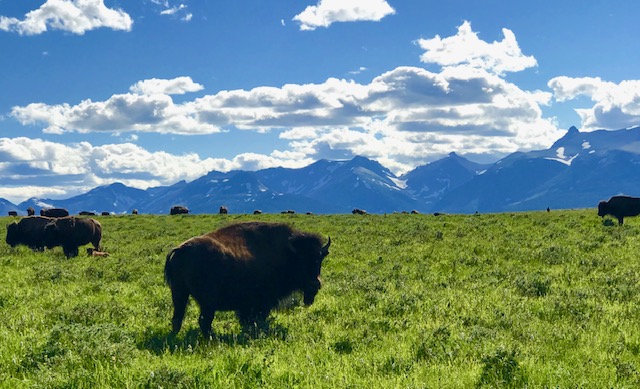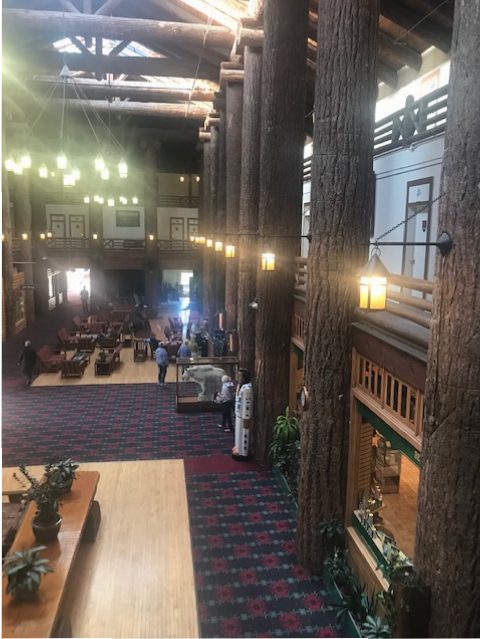Located in Western Montana are two Tribal Nations, the Blackfeet Nation of the Blackfeet Indian Reservation and the Confederated Salish and Kootenai Tribes of the Flathead Indian Reservation. Tribal history and culture can be added to any existing itinerary incorporating a Tribal Nations experience into your time spent in Glacier County. If you have a motorcoach tour, please be sure to call entities in advance to schedule your tours with a docent or tribal member.

Missoula
Begin your day in Missoula—known as the Garden City—with a visit to the Payne Family Native American Center on the University of Montana campus. Built on the site of a historic Salish Indian encampment, the building is designed to reflect the legacy, heritage and culture of all Montana tribes. Housed in the building is a planetarium open to public and private offers shows that focus on star lore of different American Indian cultures. Please check with the university for showtimes.

Flathead Indian Reservation
Heading north on U.S. Highway 93 from Missoula, enter the Flathead Indian Reservation, encompassing 1.3 million acres and the south end of Flathead Lake—the largest freshwater lake in the West. The reservation is home to the Confederated Salish and Kootenai Tribes made up of the Bitterroot Salish, Pend d’Oreille and Kootenai peoples.
Arlee
This small town is named after Salish Chief Alee, with a population of just over 600 people. Arlee sits in the beautiful Jocko Valley with views of the Mission Mountains. The Arlee Powwow Esyapqeyni is a premier celebration held annually, the first weekend in July. Experience traditional dancing, singing and drumming along with hand-made beaded crafts and authentic food. Stop into the Huckleberry Patch Alpine Grill and Gift Shop for all things huckleberry (a berry that grows wild in the mountains of Montana) and the favorite berry of the region.

Just north of Arlee is the Garden of One Thousand Buddhas. While not tribal in nature, this Tibetan Buddhist garden is a site to see. Seated in the center of the one thousand Buddhas is a 24-foot figure of Yum Chenmo who represents the union of wisdom and compassion. Open year-round, visitors of all faiths spend time walking the garden and reading the Buddhist inscriptions on the rocks.

St. Ignatius
Heading north on US-93 on the Flathead Indian Reservation, the next town is St. Ignatius, with a population near 900 people. Stop to see its main attraction—St. Ignatius Mission. Built in the early 1890s, this Catholic mission has 58 hand-painted murals that adorning the walls and ceilings. The murals were painted by Brother Joseph Carignano, an Italian Jesuit who was the handyman and cook at the mission in the early 1900s. Open year-round the mission offers Sunday mass, a museum, gift shop and a log home that was the original sisters’ residence when they first arrived in 1854.

Charlo
As you leave St. Ignatius, look out to the west. You will see the Bison Range sitting on 18,500 acres. The self-driving range is open year-round, while one of the two scenic drive is open May – October, weather permitting. Today, the preserve is home to approximately 350 head of bison that are decedents of the herd that roamed the area in 1870s. In addition to bison, the Bison Range is home to elk, bighorn sheep, mule deer, pronghorn, mountain lions and black bears. ($5 private vehicle, $25 bus or tour group).

A must-stop attraction is the Ninepipes Museum of Early Montana. The museum gives a glimpse of early Montana homesteading and life on the Flathead Indian Reservation. Enjoy lunch at the Allentown Restaurant located next door at Ninepipes Lodge or grab a coffee and shop for Montana-made gifts at Great Gray Gifts.
Pablo
Headquarters for the Confederated Salish and Kootenai Tribes is located in Pablo along with the Salish Kootenai College and a notable attraction—The People’s Center. The museum highlights the Salish, Pend d’Oreille and Kootenai Tribes’ history, culture and traditions. Schedule a personal guide or use the audio presentation to understand life in the West from their perspective. Shop the shelves of beadwork, paintings, photos and jewelry in the gift shop.

Polson
As you head farther north on US-93, you will be stunned by the views of Flathead Lake—the largest freshwater lake in the West. Sitting on the southern tip of Flathead Lake is the charming community of Polson with a population of 5,000 residents. Stop in downtown and peruse its antique shops, art galleries and live theater. Stop in at the Miracle of America Museum to see an eclectic collection of curiosities. Get off the beaten path with a visit to Salish-Kootenai Dam called Seli’s Ksanka Qlispe’, formerly known as the Kerr Dam. Located on the Flathead River, this 204-foot structure has a viewing platform offering amazing canyon views and is open year-round from dawn to dusk. Stay at the tribally owned Kwataqnuk Resort and Casino in Polson and tour on Flathead Lake aboard The Shadow offering daily, sunset, dinner, brunch and specialty cruises.

Take a boat ride to Wildhorse Island State Park, a landmark as the largest island in Flathead Lake and where the Kootenai Indians were reported to have pastured horses to keep them from being stolen by other tribes. Whitewater raft or take a kayak tour with Flathead Raft Company. For the ultra-adventurous, participate in their overnight trip where you spend time with an elder or local tribal member and learn the history, culture and heritage while crafting dream catchers, medicine wheels or tanning hides. Sleep under the stars in a teepee after listening to stories of the past.
Blackfeet Indian Reservation
The 1.5 million acres of the Blackfeet Indian Reservation are home to over 17,000 enrolled members nationally—with roughly 10,000 living on the reservation today. This is one of the 10 largest tribes in the U.S. It’s located east of Glacier National Park bordering the Canadian province of Alberta. The Blackfeet Indian Reservation is easy to incorporate into an itinerary traveling on Interstate 15, north of Great Falls or traveling east on U.S. Highway 2 near Glacier National Park.
The Blackfeet were historically a hunting and gathering tribe that followed bison and moved their camps accordingly. The land that is now Glacier National Park was vital to their culture and still is today. You would be hard pressed to find a more scenic drive in the lower continental United States than the Going-to-the-Sun Road in Glacier National Park. A wilderness of lakes, towering peaks and remnants of glaciers is readily accessible. One of the best ways to experience Glacier National Park from the Blackfeet perspective is to take a tour with Sun Tours and learn insights and cultural significance and history about what Glacier National Park has meant to the Blackfeet Nation. Known by local tribal people as the Backbone of the World, the Blackfeet guides excite visitors with tales about the history and cultural connections to the local area and national park.

Browning
Headquarters for the Blackfeet Indian Reservation is Browning, on U.S. Highway 2, home to the Museum of the Plains Indian. The museum offers a comprehensive collection of cultural artifacts and exhibits including clothing, horse gear, weapons, household implements and children’s toys. The museum represents the Blackfeet, Crow, Sioux, Arapaho, Shoshone, Norther Cheyenne, Nez Perce, Flathead, Cree and Chippawa tribes. If accessing Browning from Glacier National Park on US-2, be sure to keep an eye out for the Blackfeet Nation Bison Reserve roaming in their natural habitat.

Stop in at The Blackfeet Heritage Center & Art Gallery to see dioramas of Blackfeet culture. Shop the variety of arts and crafts at Faught’s Blackfeet Trading Post for moccasins or beaded bracelets and earrings. Visit the Lodgepole Gallery & Tipi Village to purchase one of their beautiful paintings, and then spend the evening sleeping in an authentic teepee under the big Montana sky.
Each summer, usually the second weekend in July, Browning hosts the North American Indian Days—one of the largest gatherings of U.S. and Canadian tribes. The pow wow includes dancing, drumming, traditional games, an Indian relay and rodeo.
Smaller towns on the Blackfeet Indian Reservation include Babb (stop at Two Sisters Café for huckleberry pie), Starr School, Heart Butte, and East Glacier Park home to Glacier Park Lodge and the East Glacier Park Amtrak Train Station for visitors coming by train on the Empire Builder.

If group tours would like a step-on-guide, contact Blackfeet Cultural History Tour to accompany your tour to historical sites including a buffalo jump, tipi rings and medicine lodges, all making the history of Native American Indians come alive.
*To recreate (hiking, fishing, hunting, rafting etc.) on tribal lands a Tribal Conservation permit is needed and can be purchased at any convenience store on the reservations.
For additional information on touring Western Montana’s Glacier Country drop me a line or visit touroperators.glaciermt.com, I’m always here to help.
DP
December 5, 2019
Related: Amtrak, Blackfeet Nation, East Glacier Park, Festivals + Events, FIT, Flathead Lake, Glacier National Park, Group Tours, Missoula, Tour Operator


Comments